|
In April and May 2008, Grand Canyon National Park and Museum of Northern Arizona archeologists excavated a site near the confluence of the Colorado River and Palisades Creek. The site is one of nine severely eroded sites along the Colorado River corridor scheduled for excavation in a five-year timeframe. Read more about the river excavation program...

National Park Service archeologists first documented this site in 1978, and identified a number of features, including masonry rooms, storage cists, thermal or hearth features, and surface artifact scatters. Archeologists determined that the site was ancestral Puebloan based on the architecture and artifacts associated with the site. Regular monitoring of the site through the years documented severe arroyo cutting that was eroding several archeological features, destroying them and washing artifacts downstream during flash flood events. In 1995, the National Park Service attempted to stabilize this site by building a number of check dams. Unfortunately, this stabilization measure was not effective in decreasing active erosion. In severely eroded sites where stabilization efforts are repeatedly unsuccessful, data recovery (excavation) becomes the only remaining option. In 1999, minor excavations took place at the features most affected by the active arroyo cut. At that time, archeologists discovered a masonry wall, but due to limited time and funding, no further excavation was undertaken. The NPS and MNA archeologists had several specific objectives for their two 10-day field sessions at the site in 2008. In addition to excavating newly exposed features in the arroyo cuts, archeologists wanted to assess the extent of the site and to determine the nature of the masonry wall found in 1999. 
As archeologists re-exposed more of the masonry wall discovered in 1999, they saw that the wall curved and formed a circular shape. As more of the circular room was exposed, it became apparent to the archaeologists that they were uncovering a kiva that had been completely buried by the sand dunes. Kivas are subterranean circular structures found in ancestral Puebloan sites and in modern pueblos such at the Hopi Mesas or at Zuni Pueblo. Since modern Puebloan people use kivas for ceremonial purposes, archeologists suspect that kivas were used similarly in prehistoric times. Lisa Leap, Grand Canyon National Park archeologist and one of the excavation project’s co-directors, said, “Because there are so few archaeological excavations that occur in the park, it is very fortunate that we revealed such an extraordinary structure. Uncovering a kiva will enhance our interpretation of the Canyon’s prehistory, support an association with the prehistoric people living on the north and south rims, and encourage a connection with today’s Puebloan peoples.” 
The kiva that the crew excavated is approximately 12 feet (4 meters) in diameter and 6 feet (2 meters) deep. Archeologists exposed the hearth in the center of the kiva floor, several post holes where posts supporting roof beams had been, and the kiva’s ventilator shaft.
The main period of occupation at the site was approximately between 1025 A.D. and 1075 A.D., although archeologists collected evidence during the excavation that may allow them to refine the time of occupation.

Archeologists identify and classify ceramic types found in a site to date it. Many of the pottery sherds archeologists recovered during this excavation were decorated with black-on-white painted designs. Decoration styles and types of ceramics changed through time as pottery technology evolved and new decorative styles were developed.
The large number of ceramic artifacts recovered during this excavation will be classified and typed during laboratory analysis to obtain specific information about the time periods that the people lived at this site. In addition to using the ceramic and lithic artifacts to date the site, the crew collected a wooden post fragment from one room to be submitted for dendrochronology (tree ring dating). Charcoal samples were collected for radiocarbon dating, and sediments were collected for dating via a technique called optical stimulating luminescence, which measures the length of time that the sediment has been buried. 
Ceramics and other artifacts such as projectile points and stone tools, give archeologists other information about the people who lived at the site. For example, ceramic styles have limited geographic ranges in addition to limited temporal ranges, and sources for obsidian or other raw materials for projectile points or other stone tools may be distinctive. Therefore, the types of pot sherds found in a site in Grand Canyon can help archeologists determine whether the people who lived there had cultural ties to Puebloan people to the east (the Kayanta branch) or to the northwest (the Virgin branch). Information and artifacts recovered from the site will enable archeologists to develop a broad picture of the people who lived there almost a thousand years ago. Archeologists will also combine the data from this site with information recovered during the excavation of the other sites in this project along with information previously gleaned about the canyon’s prehistory to gain a more comprehensive understanding human occupation patterns, past lifeways, and the people who lived here. 
At the conclusion of their work in May, the crew of archeologists backfilled the kiva and other structures they excavated. The artifacts recovered during excavation were placed in sample bags to be transported out of the canyon by raft. Specialists at the Museum of Northern Arizona will analyze the artifacts in order to learn more about the people who lived at this site along the Colorado River. Some of these artifacts may go on public display in exhibits about the excavation project. Exhibits are planned for the Museum of Northern Arizona, Kolb Studio on the South Rim, and tribal Visitor Centers. All artifacts from the excavation will then be permanently curated in Grand Canyon National Park’s Museum Collection. Archeologists reburied the kiva and other features to help protect them from future erosion at the site in order to preserve them. The crew also planted vegetation, and recontoured the area to remove all evidence of the excavation. Leap explained, “Our goal really was to make it look like we were never here, and I think our crew did an outstanding job restoring the site to its natural appearance. Given the National Park Service’s preservation mandate, and the fact that we were working in an area nominated for wilderness designation, it is critical that we preserve and protect what remains at the site. Backfilling is the best way for us to do so.” 
In conclusion, Leap added, “This field work is just one aspect of our work in this project to understand the people that lived in the canyon a thousand years ago. The artifacts we recovered and the data we collected during our two field sessions this spring will give us important insight about who lived here, what they did, and when they were here. We will also combine this information with data collected at other sites, like our work in September and October 2007 at a site a few miles downstream, and with data from sites that were previously excavated, like at Unkar Delta, which is also in this reach of the canyon. Discovering the kiva during this excavation already exemplifies how we are learning new things about the past through this work. I am certain that we will continue to make exciting discoveries in the other excavations in this project, and in our work analyzing and compiling all the information we gather from the nine sites we are excavating.” Related Information Grand Canyon National Park Archeological Resources The River Monitoring Program generates data regarding the effects of Dam operations on historic properties, identifies ongoing impacts to historic properties within the APE [Area of Potential Effect], and develops and implements remedial measures for treating historic properties subject to damage.
|
Last updated: July 23, 2018
